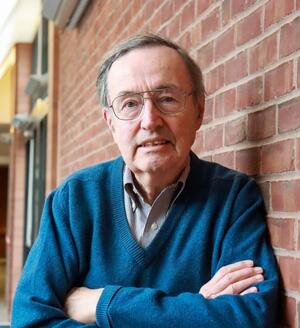Robert Howard Crabtree Lectureship
The name lectureship was established in 2020 at the behest of admiring alumni of the Crabtree Lab looking to honor their faculty advisor in perpetuity long after his retirement.
Award Recipients
2021 Melanie Sanford ‘96 University of Michigan
2022 Shannon Stahl University of Wisconsin-Madison
2023 Paul J. Chirik Princeton University
Biography
 Robert (Bob) Crabtree was a faculty member in the Yale Chemistry Department for 44 years, from 1977 to 2021, and is now an emeritus professor. Bob’s most notable work focuses on understanding the fundamental principles that underpin organometallic reactions and using this information to develop transition-metal-catalyzed reactions with applications in organic synthesis and energy storage. Among his many accolades, Bob is a fellow of the Royal Society and a member of both the American Academy of Arts and Sciences and the United States National Academy of Sciences.
Robert (Bob) Crabtree was a faculty member in the Yale Chemistry Department for 44 years, from 1977 to 2021, and is now an emeritus professor. Bob’s most notable work focuses on understanding the fundamental principles that underpin organometallic reactions and using this information to develop transition-metal-catalyzed reactions with applications in organic synthesis and energy storage. Among his many accolades, Bob is a fellow of the Royal Society and a member of both the American Academy of Arts and Sciences and the United States National Academy of Sciences.
Bob grew up in England and from an early age was interested in science, on one occasion almost blowing up his family’s garden shed performing a chemistry experiment. Bob completed his undergraduate degree at Oxford in 1966, where he undertook research with Professor Malcolm Green. This was his first exposure to organometallic chemistry, the area where he would focus his career and later write seven editions of a prominent textbook.
Bob performed his Ph.D. research under the supervision of Professor Joseph Chatt at Sussex University, where he explored the coordination chemistry of dinitrogen complexes. In 1973, Bob graduated and moved to the Institut de Chimie des Substances Naturelles in Gif-sur-Yvette, France. Bob spent four years at Gif, the first two as a postdoc with Hugh Felkin, followed by two years as an Attaché de Recherche. At Gif, Bob started to supervise students, and with a Ph.D. researcher, discovered Crabtree’s catalyst, [(COD)Ir(PCy3)(pyridine)]+[PF6]- (COD = 1,5-cyclooctadiene), one of the most active catalysts for the hydrogenation of highly substituted olefins.
In 1977, when Bob started his career at Yale, the application of organometallic chemistry to catalysis was still in its infancy. Almost immediately, Bob demonstrated that Crabtree’s catalyst could be used for the diastereoselective hydrogenation of synthetically useful olefins. Another focus of Bob’s early research at Yale was C–H activation. Here, his original advance was to reverse the hydrogenation reactions he developed at Gif, initially demonstrating a stoichiometric alkane dehydrogenation reaction. This was an early example of intermolecular C–H activation by a homogeneous metal complex. Subsequently, Bob developed catalytic systems for alkane dehydrogenation, laying the foundation for an area of research that is still active. Bob’s work on C–H activation was responsible for his interest in metal hydride and dihydrogen complexes, and he developed the T1 NMR relaxation method to determine if a complex contains a molecular hydrogen ligand.
Bob has maintained numerous long-term collaborations. Early on, Bob and Professor Odile Eisenstein collaborated on a variety of influential topics in organometallic chemistry, such as dihydrogen bonding and understanding the mechanism of transition-metal-mediated C–H bond activation. They were among the earliest researchers to combine experimental and theoretical methods to reinforce important results, a strategy now often seen in the field.
Another of Bob’s key collaborations is with his colleague, Professor Gary Brudvig. Bob and Gary published their first peer-reviewed article in 1986 and have jointly published more than 150 papers, with more in preparation. The focus of much of their work is water oxidation. A notable discovery was that the manganese di-μ-oxo dimer [{(H2O)(terpy)Mn}2(μ-O)2](NO3)3 (terpy = 2,2′:6′,2″-terpyridine) can facilitate catalytic water oxidation. More recently, Bob and Gary have published a series of papers on iridium catalysts for water oxidation. Much of this work was performed in collaboration with Yale Professors Victor Batista and the late Charles Schmuttenmaer as part of the Yale Solar Group.
Over the years, Bob also made scientific contributions in many other areas. For instance, using only an apparent relationship between odor and trends in ligand binding affinity, Bob proposed the presence of copper(I) complexes as an olfactory receptor in the nose 25 years before it was detected. In 1996, Bob reported a simple chemical reaction that destroys persistent chlorofluorocarbon pollutants with sodium oxalate. More recently, he was among the first to show palladium-catalyzed acetoxylation of arene C−H bonds using PhI(OAc)2, which is now a common oxidant.
Apart from being a distinguished chemist, Bob’s many other skills shine through professionally and personally. He received a mentoring award from the Yale Postdoctoral Association and played a major role in growing the Inorganic Chemistry Division at Yale. He is great storyteller and loves to regale students and colleagues with descriptions of both chemical concepts and his travels all around the world. Perhaps less well known is that Bob captained the Oxford shooting team and was the British National Champion over 1200 yards!
Prior to his formal retirement in 2021, Bob’s former group members and colleagues at Yale decided to honor him by starting an annual Crabtree Lecture, to be given by a leading researcher in the field of inorganic chemistry. The Crabtree Lecture is the only endowed lecture focused on inorganic chemistry at Yale and celebrates the ongoing career of a creative, prolific, and influential scientist.